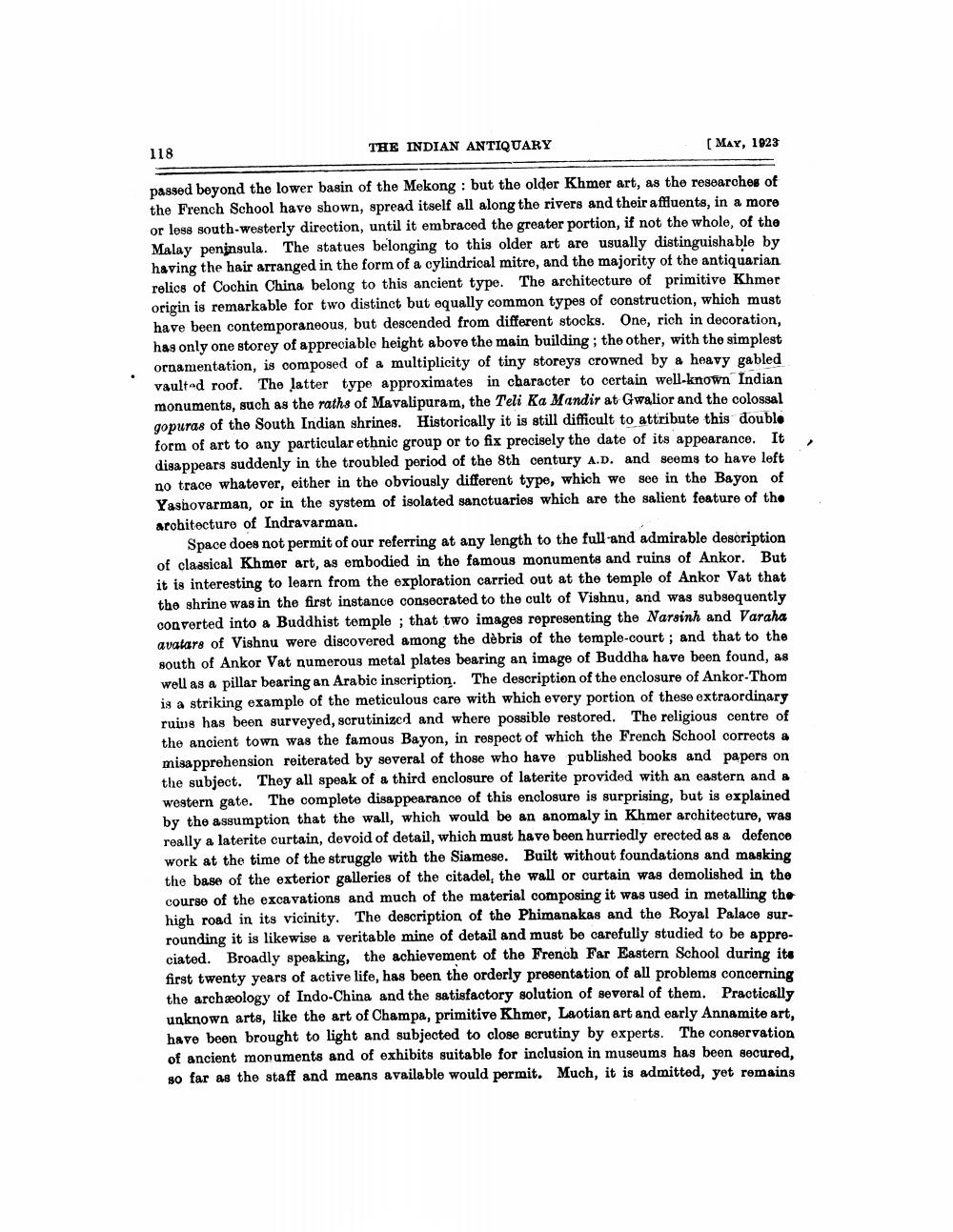________________
118
THE INDIAN ANTIQUARY
(May, 1923
passed beyond the lower basin of the Mekong: but the older Khmer art, as the researches of the French School have shown, spread itself all along the rivers and their affluents, in a more or less south-westerly direction, until it embraced the greater portion, if not the whole, of the Malay peninsula. The statues belonging to this older art are usually distinguishable by having the hair arranged in the form of a cylindrical mitre, and the majority of the antiquarian relics of Cochin China belong to this ancient type. The architecture of primitive Khmer origin is remarkable for two distinct but equally common types of construction, which must have been contemporaneous, but descended from different stocks. One, rich in decoration, has only one storey of appreciable height above the main building; the other, with the simplest ornamentation, is composed of a multiplicity of tiny storeys crowned by a heavy gabled vaulted roof. The latter type approximates in character to certain well-known Indian monuments, such as the raths of Mavalipuram, the Teli Ka Mandir at Gwalior and the colossal gopuras of the South Indian shrines. Historically it is still difficult to attribute this double form of art to any particular ethnic group or to fix precisely the date of its appearance. It disappears suddenly in the troubled period of the 8th century A.D. and seems to have left no trace whatever, either in the obviously different type, which we see in the Bayon of Yashovarman, or in the system of isolated sanctuaries which are the salient feature of the architecture of Indravarman.
Space does not permit of our referring at any length to the full and admirable description of classical Khmer art, as embodied in the famous monuments and ruins of Ankor. But it is interesting to learn from the exploration carried out at the temple of Ankor Vat that the shrine was in the first instance consecrated to the cult of Vishnu, and was subsequently converted into a Buddhist temple ; that two images representing the Narsinh and Varaha avatars of Vishnu were discovered among the dèbris of the temple-court; and that to the south of Ankor Vat numerous metal plates bearing an image of Buddha have been found, as well as a pillar bearing an Arabic inscription. The description of the enclosure of Ankor-Thom is a striking example of the meticulous care with which every portion of these extraordinary ruins has been surveyed, scrutinized and where possible restored. The religious centre of the ancient town was the famous Bayon, in respect of which the French School corrects a misapprehension reiterated by several of those who have published books and papers on the subject. They all speak of a third enclosure of laterite provided with an eastern and a western gate. The complete disappearance of this enclosure is surprising, but is explained by the assumption that the wall, which would be an anomaly in Khmer architecture, was really a laterite curtain, devoid of detail, which must have been hurriedly erected as a defence work at the time of the struggle with the Siamese. Built without foundations and masking the base of the exterior galleries of the citadel, the wall or curtain was demolished in the course of the excavations and much of the material composing it was used in metalling the high road in its vicinity. The description of the Phimanakas and the Royal Palace surrounding it is likewise a veritable mine of detail and must be carefully studied to be appreciated. Broadly speaking, the achievement of the French Far Eastern School during its first twenty years of active life, has been the orderly presentation of all problems concerning the archæology of Indo-China and the satisfactory solution of several of them. Practically unknown arts, like the art of Champa, primitive Khmer, Laotian art and early Annamite art, have been brought to light and subjected to close scrutiny by experts. The conservation of ancient monuments and of exhibits suitable for inclusion in museums has been secured, so far as the staff and means available would permit. Much, it is admitted, yet remains




